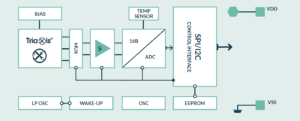Melexis – MLX90393 MICROPOWER TRIAXIS® MAGNETOMETER
The MLX90393 is the newest addition to the Melexis position sensing portfolio, bringing the highest flexibility in the portfolio’s smallest assembly. Complementing this, the magnetic field sensor is designed for micropower applications, with programmable duty cycles in the range of 0.1% to 100%.
With its 3x3mm footprint, the Melexis MLX90393 can fit in the tiniest of assemblies. It provides a digital output proportional to the sensed magnetic flux density along the 3 perpendicular axes of symmetry of the sensor. But the miniature sensor is mostly characterized by the fact that it can interchange measurement speed for both current Consumption and noise on the digital output signal, making it the raw building block for any magnetic sensing application up to 85degC.
An external microcontroller can then combine the measurement data in order to define the position of the magnet with respect to the sensor. All this at a selectable dutycycle of 0.1% to 100%.
Features:
- Micropower (2.2V – 3.6V, <5uA Idle current)
- Low-voltage I/O (1.8V – Vdd)
- SPI (3+4-wire) & I2C interface, slave node
- 16-bit XYZ magnetic and T thermal measurement
- QFN3x3 package, 16 leads
- In-application programmable (gain, mode, axes, …)
- Ta = -40 .. 85degC
Human-Machine Interface (HMI)
The MLX90393 lends itself for a wide variety of Human-Machine Interfaces such as Joystick (Gimball, Ball&Socket) with Push detection, Rotary knobs with Push function and linear strokes by levers or sliding switches. The sensor output data needs to be post-processed in order to calculate the angles or norms of the vector in order to get the desired position signal(s). This requires off-chip computation, and is a clear advantage in system-level partitioning by having one microcontroller interfacing w/ many sensors on the same bus.
Three Different Operating Modes:
- Single measurement mode
- Burst mode
- Wake-up on change mode
In single measurement mode, a bus master is requesting the sensor to perform a measurement, either by transmission of a command, or by issuing a trigger signal. Whenever the sensor is in burst mode, it is waking up and going back to sleep at a in-application programmable dutycycle. Finally, the wake-up on change function offers the same functionality as the burst mode, but only setting the interrupt pin high whenever the latest measurement differs more than a programmable threshold from either the previous measurement or the first measurement when entering the mode.
Main Applications
- Sensing element for the Internet of Things (IoT)
- Metering
– Impeller-based meters 360degree impeller position detection incl. anti tampering
– Meter mechanical counter digit readout
– General tri-axial tampering detection
– Gauss-meter - Human-machine interface
– Joystick with push function
– Rotary knob with push function
– Lever/slide switch linear stroke - Valve and piston position, industrial sensing
- Robotics & factory automation
Block Diagram











